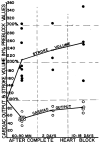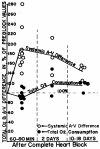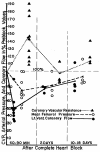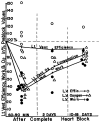Acute complete heart block in dogs
- PMID: 14390703
- PMCID: PMC2952508
- DOI: 10.1161/01.cir.12.1.82
Acute complete heart block in dogs
Abstract
A study has been conducted immediately and up to 18 days after the surgical production of complete heart block in dogs. Immediately after surgery cardiac output, coronary flow, and mean arterial pressure were reduced in rough proportion to the degree of bradycardia. In time, these measures began to return toward preoperative levels. Paralleling the diminished left ventricular work was a diminished left ventricular oxygen consumption with little consequent change in myocardial efficiency. Small rises were detected in central venous pressure. At autopsy, the only unequivocal abnormality was myocardial hypertrophy which became measurable between 2 and 18 days after operation.
Figures








References
-
- Lequime J. Le debit cardiaque. Acta med. scandinav. Suppl. 1940;107:164.
-
- Altschule MD. Physiology in Diseases of the Heart and Lungs. Harvard University Press; Cambridge: 1949.
-
- Erlanger J, Hirschfelder AD. Further studies on the physiology of heart block in mammals. Am. J. Physiol. 1906;15:153.
-
- Erlanger J, Blackman JR. A study of relative rhythmicity and conductivity in various regions of the auricles of the mammalian heart. Am. J. Physiol. 1907;19:125.
MeSH terms
Grants and funding
LinkOut - more resources
Full Text Sources

